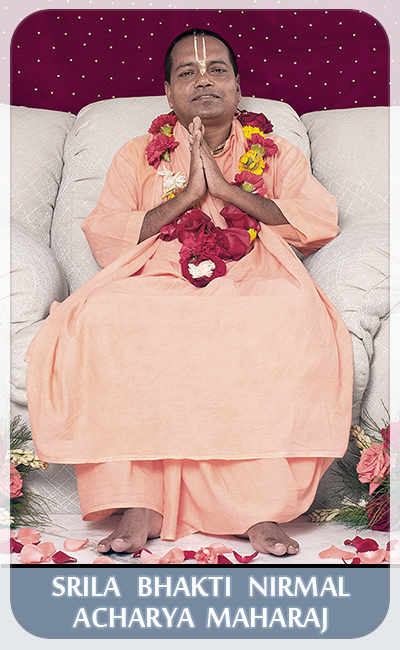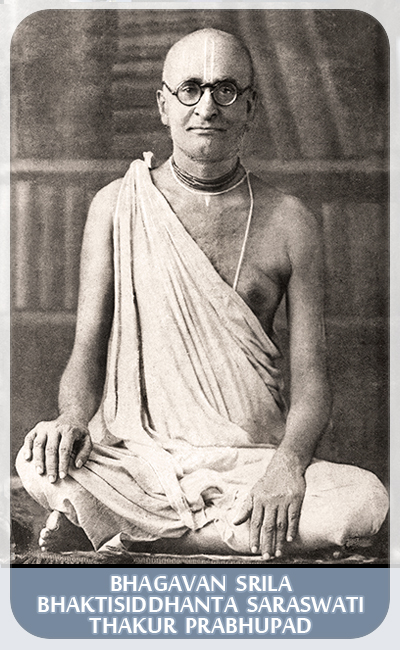Our Disciplic Succession:



|
"The Sun Never Sets on Sri Chaitanya Saraswat Math":
|
| ABOUT US | GUIDANCE | LIBRARY | DAILY PRACTICE | PHOTO | CALENDAR | CONTACT |
Vaishnavs: Not What They Seem
His Divine Grace Om Vishnupad
Srila Bhakti Nirmal Acharya Maharaj
24 June 2010
Sanatan Goswami asked, "কই সে হিত হয়, koi se hita haya? What is good for us?" There are many things told, many ways—sravanam, kirtanam, etc.
আদৌশ্রদ্ধা ততঃ সাধুসঙ্গোঽথ ভজনক্রিয়া ।
ততোঽনর্থনিবৃত্তিঃ স্যাৎ ততো নিষ্ঠা রুচিস্ততঃ ॥
অথাসক্তিস্ততো ভাবস্ততঃ প্রেমাভ্যুদঞ্চতি ।
সাধকানাময়ং প্রেম্ণঃ প্রাদুর্ভাবে ভবেৎ ক্রমঃ ॥
adau sraddha tatah sadhu-sango 'tha bhajana-kriya
tato 'nartha-nivrttih syat tato nistha ruchis tatah
athasaktis tato bhavas tatah premabhyudanchati
sadhakanam ayam premnah pradurbhave bhavet kramah
"In the beginning there must be faith. Then one becomes interested in associating with pure devotees. Thereafter one is initiated by the spiritual master and executes the regulative principles under his orders. Thus one is freed from all unwanted habits and becomes firmly fixed in devotional service. Thereafter, one develops taste and attachment. This is the way of sadhana-bhakti, the execution of devotional service according to the regulative principles. Gradually emotions intensify, and finally there is an awakening of love. This is the gradual development of love of Godhead for the devotee interested in Krishna consciousness."
Bhakti-rasamrita-sindhu, 1.4.15–16
It is written very nicely. Adau sraddha, first is sraddha, and then sukriti comes from sraddha.
And Nityananda Prabhu said only one thing, and very strongly:
"How to prosper in our life?"
"যাও! ভাগবত পড় বৈষ্ণবের স্থানে, একান্ত আশ্রয় কর চৈতন্য-চরণে: Bhagavata pada Vaisnavera sthane, ekanta asraya kara Chaitanya-charane! Yao! Go—go! Read Bhagavatam under the guidance of bona fide Vaishnavs and take shelter at Mahaprabhu's lotus feet! That is your benefit." Nityananda Prabhu is saying like this.
Question: Could you please explain to us the qualification of a Vaishnava?
One time Prabhupad Srila Bhakti Siddhanta Saraswati Thakur went to give a lecture in some place near Delhi. The people thought a guru was coming and he would have long hair, a big beard, like that, and when Prabhupad came, they saw a simple man. The audience was unhappy, and Prabhupad started his lecture with, "I cannot see anybody here who can recognise a Vaishnav, who has the eyes to see a Vaishnav!"
Krishna Das Kaviraj Goswami explained it, and Mahaprabhu's conception is the same. There is a Vaishnav (ordinary Vaishnav), a Vaishnavatara (better Vaishnav), and a Vaishnavatama (best Vaishnav), three different qualities of a Vaishnav. It is same as uttam Vaishnav, madhyam Vaishnav, and kanistha Vaishnav.
Gurudev and all our Acharyas are uttam-adhikari, but they have to come down to the stage of madhyam-adhikari because an uttam-adhikari Vaishnav always sees the Lord everywhere, he does not even see a disciple, so he cannot make a disciple. For an uttam-adhikari to take a disciple, he has to come down to the middle stage. Do you understand?
Mahaprabhu also said: those who chant the Holy Name, Krishna Nam, once are also Vaishnavs. And those who always chant Krishna Nam are madhyam-adhikari. And uttam-adhikari is:
যাঁহার দর্শনে মুখে আইসে কৃষ্ণনাম ।
তাঁহারে জানিহ তুমি 'বৈষ্ণব-প্রধান' ॥
yanhara darsane mukhe aise krsna-nama
tanhare janiha tumi 'vaisnava-pradhana'
Sri Chaitanya-charitamrita, Madhya-lila, 16.74
"When somebody sees you and Krishna comes to their mouth, then you are an uttam-adhikari."
And Gurudev also told one time about the three kinds of disciples:
Gurudev tells a disciple, "Do this job," but he does not do it. That is adham, the lowest. Gurudev tells a disciple, "Do this," and he does it. And the third kind is when Gurudev does not have to tell—the disciple does it himself. These are the three different qualities.
Prabhupad Bhakti Siddhanta Saraswati Thakur explained also, "সংসার ভিতরে, না বাহিরে; samsara bhitare, na bahire." You cannot recognise a Vaishnav through your eyes. You have to acquire the eyes, the qualification, then you can recognise through your eyes who is a Vaishnav and who is not a Vaishnav. You must see the Vaishnav not with your eyes—you must see the Vaishnav through your ears!
Samsara bhitare, na bahire [সংসার ভিতরে, না বাহিরে, lit. material life is within, not without] means that somebody may be wearing saffron colour, may be in a sannyasi dress, but they can be a hypocrite if they do not practise, do not follow the sannyas rules and regulations. In another way, it means you cannot recognise who has a wife and who has no wife just by the clothes. These are strong words...
| ◄ | ► |
{ 2001 |
2002 |
2003 |
2005 |
2009 |
2010 |
2011 |
2012 }
{ 2013 |
2014 |
2015 |
2016 |
2017 |
2018 |
2019 |
2020 |
2021 }
| Stay On Board |
|---|
| The key how not to find yourself thrown off the board: take in the Captain's instructions and stay on board without discriminating against the members of the family. |
| Janama saphala ta'ra |
|---|
| 'I eternally desire to take the form of a bee, easily attain a place at Krishna's lotus feet, and sing His glories. I will never serve anyone else.' | জনম সফল তা'র |
 |
“Actually,
we do not know what is good for us. We think we will get benefit in this way, and we go that way, but then some problem comes.” |
 |
Sitemap | Contact us | About us
